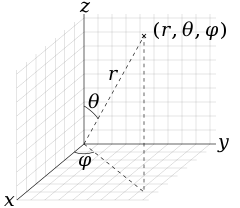
Back Sferiese koördinatestelsel Afrikaans نظام الإحداثيات الكروية Arabic Сферычная сістэма каардынат Byelorussian Сферична координатна система Bulgarian Kenurzhiennoù sferek Breton Sistema de coordenades esfèriques Catalan Sférická soustava souřadnic Czech Координатсен сферăлла тытăмĕ CV Sfærisk koordinatsystem Danish Kugelkoordinaten German

In mathematics, a spherical coordinate system is a coordinate system for three-dimensional space where the position of a given point in space is specified by three real numbers: the radial distance r along the radial line connecting the point to the fixed point of origin; the polar angle θ between the radial line and a given polar axis;[a] and the azimuthal angle φ as the angle of rotation of the radial line around the polar axis.[b] (See graphic regarding the "physics convention".)
Once the radius is fixed, the three coordinates (r, θ, φ), known as a 3-tuple, provide a coordinate system on a sphere, typically called the spherical polar coordinates.
The plane passing through the origin and perpendicular to the polar axis (where the polar angle is a right angle) is called the reference plane (sometimes fundamental plane).
Cite error: There are <ref group=lower-alpha> tags or {{efn}} templates on this page, but the references will not show without a {{reflist|group=lower-alpha}} template or {{notelist}} template (see the help page).